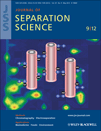
JOURNAL OF SEPARATION SCIENCE
Scope & Guideline
Pioneering Innovations in Analytical Chemistry
Introduction
Aims and Scopes
- Separation Techniques and Methodologies:
The journal covers a wide range of separation techniques, with a strong emphasis on chromatography and electrophoresis. This includes high-performance liquid chromatography (HPLC), capillary electrophoresis, and supercritical fluid chromatography, showcasing both fundamental research and practical applications. - Analytical Chemistry:
Research published in this journal frequently intersects with analytical chemistry, particularly in the development and optimization of methods for analyzing complex mixtures, including pharmaceuticals, environmental samples, and food products. - Biochemical Applications:
The journal explores the application of separation techniques in biochemical contexts, including the purification of biomolecules such as proteins, peptides, and nucleic acids, as well as the assessment of metabolic profiles in biological samples. - Green Chemistry and Sustainability:
A commitment to sustainability is evident in recent publications, with a focus on environmentally friendly extraction methods, use of green solvents, and the development of sustainable separation techniques. - Emerging Technologies:
The journal also highlights advancements in separation technologies, including the use of nanomaterials and novel stationary phases, as well as the integration of separation techniques with mass spectrometry for enhanced analytical capabilities.
Trending and Emerging
- Hybrid and Multi-Dimensional Approaches:
There is a rising trend in the use of hybrid and multi-dimensional separation techniques, which combine various methodologies to enhance the resolution and efficiency of separations. - Nanomaterials and Advanced Sorbents:
Research focusing on the application of nanomaterials and advanced sorbents in separation processes is gaining traction, highlighting their effectiveness in improving extraction and separation processes. - Eco-Friendly and Green Extraction Techniques:
A significant increase in publications addressing green chemistry principles in separation science, including the use of deep eutectic solvents and other sustainable practices, reflects a broader movement toward environmentally conscious research. - Integration with Mass Spectrometry:
The integration of chromatography with mass spectrometry continues to be a prominent trend, facilitating more comprehensive analyses and deeper insights into complex biological and environmental samples. - Metabolomics and Biochemical Profiling:
Emerging themes in metabolomics and the biochemical profiling of natural products indicate a growing interest in the application of separation science to understand complex biological systems and drug interactions.
Declining or Waning
- Traditional Separation Techniques:
There has been a noticeable decrease in publications focusing solely on traditional separation techniques without innovative modifications or applications. As newer technologies and methodologies emerge, traditional methods appear less frequently. - Single-Dimensional Chromatography:
Research that emphasizes single-dimensional chromatography techniques is declining in favor of multi-dimensional and hyphenated approaches that provide more comprehensive analysis capabilities. - Non-Sustainable Practices:
As the focus on sustainability in separation science grows, methods that do not adhere to environmentally friendly practices are becoming less prevalent in favor of greener, more efficient techniques.
Similar Journals
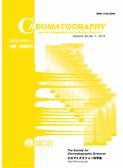
Chromatography
Elevating analytical science through rigorous chromatography studies.Chromatography is an esteemed journal published by the SOC CHROMATOGRAPHIC SCIENCES, dedicated to advancing the field of chromatographic techniques and their applications across various disciplines, including analytical chemistry, biochemistry, and environmental science. By facilitating the exchange of high-quality research, Chromatography plays a pivotal role in enhancing methodologies and technologies that drive innovation in sample analysis. While the journal is not currently open access, it maintains a rigorous peer-review process, ensuring the publication of valuable and impactful studies. Researchers, professionals, and students alike can benefit from its comprehensive coverage of chromatography-related advancements, making it a vital resource for anyone engaged in this dynamic area of study.
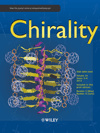
CHIRALITY
Navigating the Complexities of Chirality in Modern ScienceCHIRALITY is a prominent journal in the field of chemistry, published by Wiley. Established in 1989, it has become a critical resource for researchers and professionals interested in the intricate study of chiral compounds across various applications, including analytical chemistry, catalysis, drug discovery, organic chemistry, pharmacology, and spectroscopy. With an ISSN of 0899-0042 and an E-ISSN of 1520-636X, CHIRALITY currently holds a Q2 ranking in Analytical Chemistry and Q3 rankings in several other categories based on the latest assessments. Although it does not offer open access, the journal is widely recognized for disseminating high-quality research that contributes significantly to our understanding of chirality. Its impact is reflected in its Scopus rankings, indicating the journal's influence and relevance within the broader scientific community. Researchers, students, and professionals alike will find CHIRALITY an invaluable conduit for cutting-edge findings and developments in chirality-related research.

RADIOCHEMISTRY
Illuminating the Science Behind Radioactive ElementsRADIOCHEMISTRY, published by PLEIADES PUBLISHING INC, is a prominent journal focusing on the dynamic field of radiochemistry, encompassing both theoretical and experimental research in the application of radioactive elements and isotopes across various scientific domains. With the ISSN 1066-3622 and e-ISSN 1608-3288, this journal has been a vital resource for scholars since its inception, converging years of valuable research from 2003 to 2024. The journal currently holds a Q4 category quartile in the Physical and Theoretical Chemistry field, reflecting its niche position within this specialized discipline. Despite ranking #156 out of 189 in Scopus for Chemistry Physical and Theoretical Chemistry, with a 17th percentile ranking, RADIOCHEMISTRY continues to serve as an important forum for advancing knowledge and fostering collaboration among researchers and professionals dedicated to the study of radiochemical processes. Although it does not offer Open Access, researchers are encouraged to delve into its rich content for insights and advancements in radiochemistry.

Acta Chemica Iasi
Unlocking Knowledge, Inspiring DiscoveryActa Chemica Iasi is a distinguished open-access journal dedicated to advancing the field of chemistry, published by the esteemed ALEXANDRU IOAN CUZA UNIVERSITY PRESS located in Iasi, Romania. Since its inception, this journal has served as a vital platform for the dissemination of significant research findings, theoretical advancements, and methodological innovations in various chemistry disciplines. As an open-access publication since 2013, it provides unrestricted access to high-quality articles, fostering collaboration and knowledge sharing among researchers, professionals, and students globally. Although specific metrics such as H-Index and Scopus rankings may be forthcoming, the journal's commitment to rigor and excellence ensures that it remains an invaluable resource for those seeking to stay at the forefront of chemical research. With a focus on promoting scientific inquiry and innovation, Acta Chemica Iasi continues to uphold a legacy of scholarly excellence and contribution to the chemical sciences.

ANALYTICAL AND BIOANALYTICAL CHEMISTRY
Illuminating the Path of Chemical InnovationANALYTICAL AND BIOANALYTICAL CHEMISTRY, published by SPRINGER HEIDELBERG, is a leading international journal that serves as a vital platform for innovative research in the fields of analytical and bioanalytical chemistry. With an impressive impact factor and ranking in the Q2 category for both Analytical Chemistry and Biochemistry, the journal highlights key advancements and methodologies that drive the discipline forward. Established in 1996 and continuing vigorously into 2024, it has gained significant recognition with Scopus rankings placing it in the 83rd and 78th percentiles within its categories, underscoring its impact and relevance. The journal's commitment to open access facilitates widespread dissemination of critical scientific knowledge, making it an essential resource for researchers, professionals, and students dedicated to exploring the complexities of chemical analysis. With its base in Heidelberg, Germany, ANALYTICAL AND BIOANALYTICAL CHEMISTRY continues to inspire and influence the global research community.

JPC-JOURNAL OF PLANAR CHROMATOGRAPHY-MODERN TLC
Pioneering Techniques in Planar Chromatography.JPC-JOURNAL OF PLANAR CHROMATOGRAPHY-MODERN TLC, published by Springer Heidelberg, is a pivotal resource in the fields of Analytical Chemistry, Biochemistry, and Clinical Biochemistry. With an ISSN of 0933-4173 and an E-ISSN of 1789-0993, this journal serves as an essential platform for the dissemination of innovative research on planar chromatography techniques, specifically modern thin-layer chromatography (TLC). With its upcoming coverage extending to 2024 and a third quartile ranking (Q3) across major scientific categories in 2023, it addresses the critical advancements and applications in analytical methods. Although it does not offer open access, the journal's rigorous peer-review process ensures high-quality findings that contribute to the progression of these vital scientific disciplines. The journal is located in Heidelberg, Germany, and continues to be a beacon for researchers, professionals, and students who seek to enhance their knowledge and practice in chromatographic techniques.

LCGC EUROPE
Exploring the forefront of chromatographic techniques in Europe.LCGC EUROPE is a prominent journal dedicated to the field of analytical chemistry, specifically highlighting the latest trends and innovations in chromatographic techniques. Published by MJH Life Sciences, this journal has served as a valuable resource for researchers, professionals, and students interested in the nuances of laboratory practices and the advancement of instrumentation. Although LCGC EUROPE ceased its coverage in Scopus from 2018, it has maintained a significant influence within the community, evidenced by its Scopus rank of 90/114 in Analytical Chemistry, placing it in the 21st percentile. With its inception dating back to 1996, the journal provided essential insights and peer-reviewed articles, fostering a rich understanding of chromatographic science. While the journal is not currently open access, it remains an integral part of the literature for anyone engaged in the analytical chemistry landscape, especially as it pertains to laboratory methodologies and innovations.

Filtration + Separation
Navigating Trends in Filtration Technology and SustainabilityFiltration + Separation is a distinguished journal published by MA HEALTHCARE LTD, specializing in the fields of filtration technology, separation processes, and their applications within environmental science and industrial engineering. With a commitment to advancing knowledge in these critical areas, this journal, established in 1970, has consistently provided a platform for innovative research and developments, catering to the unique challenges of the filtration and separation industry. Despite its recent categorization in the Q4 quartile across various fields, including Environmental Science and Industrial Engineering, it remains pivotal for researchers and professionals seeking to stay abreast of emerging trends and technologies. The journal is accessible through traditional subscription models and aims to bridge the gap between academic research and practical applications. As the industry evolves, Filtration + Separation continues to serve as an invaluable resource for both seasoned experts and budding scholars passionate about enhancing separation processes and environmental sustainability.
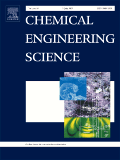
CHEMICAL ENGINEERING SCIENCE
Elevating Knowledge in Chemical Engineering and BeyondChemical Engineering Science is an esteemed journal published by Pergamon-Elsevier Science Ltd, dedicated to advancing the field of chemical engineering through high-quality research and innovation. With a storied history spanning from 1951 to 2025, this journal is recognized as a leading platform for disseminating cutting-edge studies, encompassing a diverse range of topics within chemical engineering, applied mathematics, and industrial engineering. Notably, it holds a prestigious Q1 ranking in several categories, including Chemical Engineering and Industrial and Manufacturing Engineering, indicating its significant impact and influence in these fields. The journal is not open access, yet it maintains a robust readership and is widely cited in academic circles, reflecting its vital role in shaping modern engineering practices. As a vital resource for researchers, professionals, and students alike, Chemical Engineering Science continues to bridge theoretical concepts and practical applications, fostering a deeper understanding of the complex challenges in chemical processes and manufacturing.
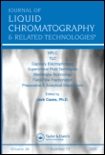
JOURNAL OF LIQUID CHROMATOGRAPHY & RELATED TECHNOLOGIES
Catalyzing Discoveries in Biochemistry and BeyondJOURNAL OF LIQUID CHROMATOGRAPHY & RELATED TECHNOLOGIES, published by Taylor & Francis Inc, is a pivotal platform for disseminating cutting-edge research in the field of liquid chromatography and its applications across various disciplines including analytical chemistry, biochemistry, and pharmaceutical science. With an ISSN of 1082-6076 and an E-ISSN of 1520-572X, this journal serves as an essential resource for researchers, professionals, and students committed to advancing the understanding and development of chromatographic techniques. Despite not being an open access publication, the journal features a robust submission process from 1996 to 2024, ensuring comprehensive coverage of historical and contemporary methodologies. Notably, it has achieved rankings in the Q3 and Q4 quartiles across various categories, reflecting its reputable position in the field. It’s recognized within key databases, with Scopus ranks indicating its influential role in areas such as pharmaceutical science and analytical chemistry. This journal is not only a cornerstone for specialized studies but also fosters interdisciplinary collaborations, making it an invaluable asset for the scientific community.